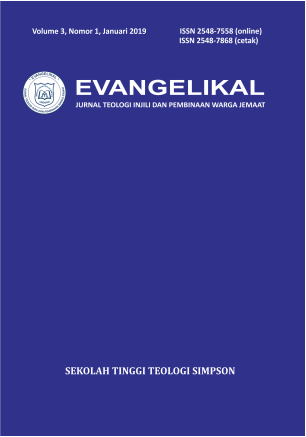Pola Hermenetik Sastra Hikmat Orang Ibrani
DOI:
https://doi.org/10.46445/ejti.v3i1.123Keywords:
Wisdom Literature, Hermeneutics, Old Testament Methods, Sastra Hikmat Orang Ibrani, Hermenetik, Metodologi Perjanjian LamaAbstract
Sonny Eli Zaluchu, The Hermenetic Pattern of Hebrew Wisdom Literature. Hebrew Wisdom Literature is one of the most distinctive kinds of literature that can found in the Old Testament. Particular hermeneutic patterns are needed to interpret literary books. The writings of the wisdom literature of the Hebrew people are rich in various types of literary styles from being oral traditions to written forms and being part of the Old Testament canon. This paper aims to form a hermeneutic pattern in the form of defining literary categories, capturing the main ideas of the writer, seeing the text in context, and paying attention to the style of language. Studying these four patterns will help the interpreter elevate the meaning of the contents of the literature of Wisdom. Writing presented in a descriptive, analytical form.
Â
Sonny Eli Zaluchu, Pola Hermenetik Sastra Hikmat Orang Ibrani. Sastra Hikmat Orang Ibrani adalah salah satu sastra yang sangat khas yang dapat dijumpai di dalam Perjanjian Lama. Diperlukan pola hermenetik khusus untuk melakukan penafsiran terhadap kitab-kitab sastra tersebut. Hal tersebut diper-lukan karena tulisan sastra hikmat orang ibrani kaya dengan berbagai jenis gaya kesusasteraan sejak men-jadi tradisi oral hingga dalam bentuk tertulis dan menjadi bagian dari kanon Perjanjian Lama. Tulisan ini bertujuan merumuskan pola hermenetik berupa menentukan kategori sastra, menangkap gagasan utama penulis, melihat teks di dalam konteks, dan memperhatikan gaya bahasa. Mempelajari keempat pola ter-sebut akan menolong penafsir mengangkat makna dari isi kitab-kitab sastra Hikmat. Tulisan disajikan di dalam bentuk deskriptif analitis.
References
Adamo, D. T. 2015. “Ancient Israelite and African proverbs as advice, reproach, warning, en-couragement and explanation.†Hts Teologiese Studies-Theological Studies, 71 (3): 01-13. https://doi.org/10.4102/hts.v71i3.2972
Alexander, T. D., Rosner, B. S., Carson, D. ., & Goldsworthy, G. 2000. New Dictionary of Biblical Theology. Nottingham: InterVarsity Press.
Dell, K. J. 2006. The Book of Proverbs in Social and Theological Context. https://doi.org/ 10.1017/CBO9780511488306
Douglas, J. D. 2005. Ensiklopedi Alkitab Masa Kini (1st ed.). Jakarta: Yayasan Bina Kasih / OMF.
Fox, M. V. 2007. “The Epistemology of the Book of Proverbs.†Journal of Biblical Literature , 126.4: 669-684. https://doi.org/10.2307/ 27638461
Freeman, J. M. 1988. The New Manners and Customs of the Bible. Alachua, Florida: Bridge-Lagos.
Gaebelein, F. E. 1991. Psalms, Proverbs, Ecclesiastes, Song of Songs. The Expositor’s Bible Commentary with The New International Version of the Holy Bible.
Gardner, P. D. 1995. Encyclopedia of Bible Characters. Michigan: Zondervan.
Gertz, J. C., Berlejung, A., Schmid, K., & Witte, M. 2017. Purwa Pustaka: Eksplorasi ke dalam Kitab-kitab Perjanjian Lama dan Deuterokanonika. Jakarta: BPK Gunung Mulia.
Goldsworthy, G. 2011. “Wisdom and its Literature in Biblical-Theological Context.†The Sout-hern Baptist Journal of Theology, 15: 42-55.
Handbook to the Bible. 2004. Bandung: Kalam Hidup.
Kittel, G. 1971. Theological Dictionary of the New Testament. Grand Rapids, Michigan: Eerdmans.
Klein, W. W., Blomberg, C. L., & Hubbard, R. L. 2013. Biblical Interpretation 2 Pengantar Tafsiran Alkitab. Malang: Literatur SAAT.
Knut, H. 2010. Prov 26:1-12: A Crash Course on the Hermeneutics of Proverb Reception and a Case Study in Proverb Performance Response. Die Welt Des Orients.
Koller, A. 2012. “Diachronic change and synchronic readings: Midrashim on stative verbs and participles.†Journal of Semitic Studies, 57 (2): 265-294. https://doi.org/10.1093/jss/ fgs003
Leeuwen, R. van. 2005. “Wisdom Literature.†In K. J. Vannhoozer, C. G. Bartholomew, D. T. Treier, & Wright (Eds.), Dictionary for Theological Interpretation of the Bible. Grand Rapids, Michigan: Baker Academic.
Murphy, R. E. 1982. The Tree of Life: An Explo-ration of Biblical Wisdom Literature (2nd ed.). Grand Rapids, Michigan: Eerdmans.
Notarius, T. 2011. “Temporality and Atemporality in the Language of Biblical Poetry.†Journal of Semitic Studies, 56 (2): 275-305. https:// doi.org/10.1093/jss/fgr004
Osborne, G. R. 2012. Spiral Hermeneutika. Surabaya: Penerbit Momentum.
Palmer, R. E. 2016. Hermenetika - Teori Baru Mengenai Interpretasi (Edisi III). Yogyakarta: Pustaka Pelajar.
Renn, S. D. 2005. Expository Dictionary of Bible Words. Massachussets: Hendrickson Publisher.
Roberge, J. 2011. What is critical hermeneutics? Thesis Eleven. https://doi.org/10.1177/ 0725513611411682
Schmidt, L. K. 2009. Understanding hermeneutics. Understanding Hermeneutics. https:// doi.org/10.1017/UPO9781844653843
Zabán, B. 2016. “Metaphors in the Wisdom Literature of the Hebrew Bible and Contemporary Art.†Religions, 7 (9): 106. https:// doi.org/10.3390/rel709010






5.jpg)

